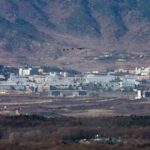Long-Range Drones and Loitering Munitions: South Korea’s Defense Strategy Against North Korea
Daniel Kim Views

In late December 2022, a small unmanned aerial vehicle (UAV) deployed by North Korea near South Korea’s presidential office raised alarms across Seoul, prompting a significant military response. In response to this incursion, South Korea established a dedicated drone operations command, officially launched on September 1, 2023, at the Army’s 15th Aviation Division airstrip in Pocheon, Gyeonggi Province. This command was highlighted during the 75th Armed Forces Day celebration, where multiple drones were displayed, demonstrating South Korea’s growing focus on drone warfare amid heightened provocations from the North.
The drone operations command operates under the South Korean Joint Chiefs of Staff and is tasked with both reconnaissance and combat drone operations. Unlike traditional service branch assets, this specialized unit is designed to perform intelligence gathering and offensive operations. Its primary mission includes real-time surveillance, rapid decision-making, and precision strike capabilities to neutralize threats during heightened conflict.
Expanding Drone Fleet: From Recon to Precision Strikes

Currently, South Korea’s drone operations command operates around 100 reconnaissance drones, with expansion plans that include long-range reconnaissance drones, loitering munitions, and stealth UAVs. North Korea recently criticized these activities, accusing South Korea of violating its sovereignty. The North pointed to a drone model similar to South Korea’s long-range reconnaissance UAVs as evidence of this infringement.
South Korea’s long-range reconnaissance drone program began as a rapid acquisition project between 2020 and 2021. Developed by Seongwoo Engineering, the Argos-based UAV can fly autonomously on pre-programmed routes, launching via catapult and landing via parachute. This drone can reach speeds of 93 mph and has an endurance exceeding four hours, enabling round trips between the Military Demarcation Line (MDL) and Pyongyang, roughly 93 miles one way. Operating at an altitude of 1.2 miles, it can cover a maximum range of 248 miles. It has a 4K DSLR camera, allowing for high-resolution surveillance deep within enemy territory. Its covert capabilities enable South Korea’s military to gather critical intelligence without detection.
Loitering Munitions and Enhanced Strike Capabilities
Recently, military authorities disclosed the purchase of loitering munitions. On October 2, the Defense Acquisition Program Administration announced a contract to acquire the Warmate loitering munition from Polish manufacturer WB Electronics. The deal was signed during the Korea International Defense Industry Exhibition (KADEX) held at the emergency runway in Gyeryongdae, Chungcheongnam-do. While specific details remain classified, sources indicate the contract involves around 200 units at approximately 15 billion won ($11.3 million).
This procurement comes amid escalating tensions following North Korea’s August unveiling of its own loitering munitions. In recent conflicts, particularly in Ukraine, low-cost loitering munitions like the Warmate have proven highly effective against high-value targets, such as tanks, underscoring their role as impactful assets in modern warfare. These drones have demonstrated precise strike capabilities on Ukrainian battlegrounds, enhancing their strategic appeal.
The Warmate, already deployed by Ukrainian forces, offers immediate delivery options. The South Korean military expects to receive units in November and complete their integration into the drone operations command by December.
Compact and versatile, the Warmate measures 5.25 feet wide and 3.6 feet long and supports a range of payloads, including high-explosive warheads. It operates via a pneumatic launch system, using compressed air cartridges to propel it from its platform. Once airborne, the Warmate loiters around target zones, utilizing visual data to execute precision strikes. Notably, in April, the Warmate demonstrated its battlefield effectiveness by neutralizing a Russian radar site for surface-to-air missile systems, underscoring its potential value in South Korea’s defense strategy.

The South Korean military employs a dual-tiered structure for drone and UAV operations. Each branch manages its own assets, while the centralized drone operations command oversees specialized capabilities, including high-end reconnaissance, loitering munitions, and stealth drones. In line with this approach, military planners aim to double South Korea’s overall drone capacity by 2026.
As of 2023, Army Headquarters reported an inventory exceeding 510 UAVs, distributed across different operational levels: three units for Ground Operations Command, around 20 at the corps level, 50 at the division level, and 440 at the battalion level.
The Navy’s drone assets include unmanned reconnaissance aircraft deployed from two intelligence vessels, the Shinsegi and Shinkiwon. These ships operate fewer than ten Camcopter S100 rotary-wing UAVs from Austria’s Schiebel, specifically designed for intelligence gathering on North Korea. Compact yet capable, these drones, at 9.8 feet in length and weighing 330 pounds, provide real-time video feeds, enhancing maritime reconnaissance. While the Air Force lacks dedicated reconnaissance UAVs, it uses drones for base security operations.
Advanced Reconnaissance: RQ-4 Global Hawk and Division-Level UAVs
A significant asset for South Korea’s high-altitude surveillance is the RQ-4 Global Hawk, with four units in the Air Force inventory. Known for deep-penetration surveillance, the RQ-4 is equipped with Synthetic Aperture Radar (SAR) and Electro-Optical/Infrared (EO/IR) sensors. It can fly for up to 3,417 miles, covering 54,000 square miles from an altitude of 65,617 feet, and has a maximum endurance of 36 hours. Its most notable feature is its ability to detect objects as small as 12 inches on the ground, rivaling satellite systems. South Korea acquired two Global Hawks in 2018 and two more in 2019, cementing its advanced aerial reconnaissance capabilities.

The South Korean Army primarily handles tactical drones and UAVs for various operational needs, with the corps-level Songgolmae (RQ-101) playing a critical role in surveillance near the Demilitarized Zone (DMZ). First deployed in 2000, the Songgolmae was designed to monitor enemy movements and deliver real-time battlefield intelligence. With a length of 15.7 feet and a wingspan of 20.9 feet, it reaches speeds of up to 115 mph and operates at altitudes of 14,764 feet for six-hour missions, covering a radius of 68 miles. Equipped with TV cameras and Forward-Looking Infrared (FLIR) sensors, it conducts day-and-night surveillance, monitors combat situations, tracks targets, aids artillery adjustments, and assesses battle damage. The Songgolmae launches from a catapult and uses a parafoil system for recovery, enabling autonomous operations on pre-set flight paths.
In addition to the Songgolmae, the Army procured the Heron UAV from Israel in 2014 to strengthen surveillance over the Northwestern Islands and areas near Seoul. This medium-altitude, long-endurance UAV operates between 29,528 and 32,808 feet, supports payloads up to 551 pounds, and can stay airborne for more than 40 hours, ensuring extended surveillance over strategic areas. These UAVs enhance the Army’s intelligence-gathering capabilities and support the broader tactical operations essential to South Korea’s defense posture.



The Army utilizes unmanned reconnaissance aircraft at both the division and battalion levels to enhance its surveillance and target acquisition capabilities. The division-level UAV, which became fully operational in 2021, can pinpoint objects beyond 6.2 miles and automatically track targets. Designed for South Korea’s challenging mountainous terrain, this UAV features dual-aircraft functionality, enabling continuous 24-hour mission coverage. It can execute steep descents for landing in confined spaces and performs automatic landings in low-visibility conditions, halting within 98 feet of touchdown.
Based on Korean Air’s KUS-9 airframe, this division-level UAV weighs 330 pounds and meets military-grade specifications. It operates at altitudes up to 13,123 feet for eight hours, covering an operational radius of 37 miles. Launched from a mobile trailer and retrieved by a net, it conducts area surveillance, detects irregularities, and precisely identifies artillery targets.
Flexible Deployment: Battalion-Level UAVs and Responsive Operations
The Remoeye UAV offers a more hands-on deployment method at the battalion level. It is launched manually, similar to a paper airplane throw, and uses a parachute and airbag system for recovery. Equipped with interchangeable day and night cameras, the Remoeye is managed via a touch-screen ground control interface. Capable of autonomous flights on pre-set routes, it relays real-time target data and returns to base automatically once its mission is completed. These UAVs provide the Army with flexible and responsive real-time intelligence and reconnaissance tools.















Most Commented